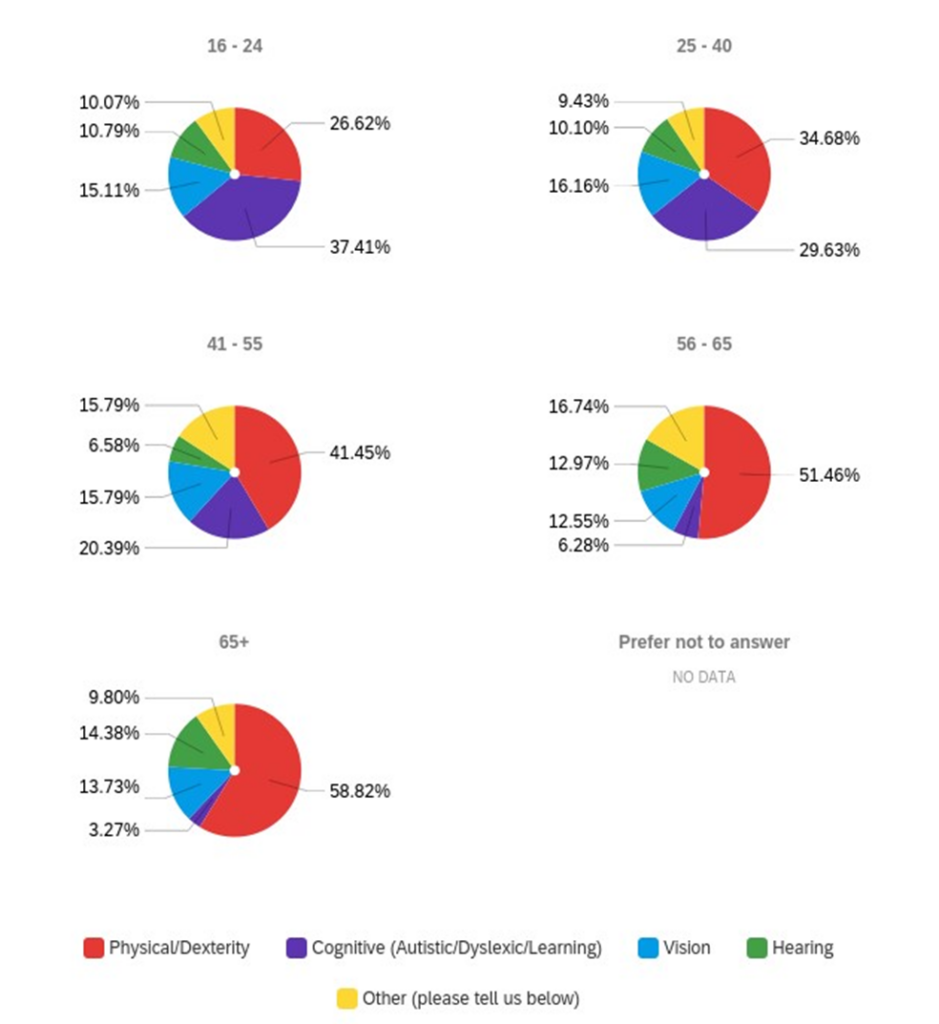Making sense of generational divides1 2
Identity and Functionality
As a market, disability consists of two elements: self-identity and functionality. Neurodiverse individuals, for example, may not qualify as “medically disabled,” but having to develop alternative methods for interacting with a given environment may cause such a person to self-identify themselves as having a disability. At its core, this is a matter of self-perception. This self-perception than affects how an individual interacts with products, services, brands, and other individuals. This self-perception may or may not be tied to a formal medical diagnosis., and may include any functional deviation from the “norm”. Technically speaking, no deviation from “normal” functionality is required for someone to self-identify as having a disability.
Functionally speaking, disability is a difference in performance from the “norm”. Such differences in functionality cause an individual to adapt to a world designed for the average user. Crucially, those with functional disabilities may or may not self-identify as having a disability. This is most noticeable as individuals age, with differences in abilities often being attributed to “slowing down” or other such common phrases. This represents a deviation in functionality, yet this same person may not, and often does not, self-identify as having a disability.
Cognitive Disability and Generational Divides
Differences between identity and functionality are starkest when it comes to cognitive disabilities, such as learning disabilities, autism, mental health, and those pertaining to information processing. From an identity perspective, conversations about disability are shifting, especially amongst younger “Millennials” and “Generation Z” who have recently or will soon enter the workforce. Two trends are noteworthy.
First, there is an increased acknowledgement of the importance of mental health. This has led to changes in both perceived functionality and self-identity. People in these generations are comparatively far more comfortable self-identifying themselves as having a cognitive disability.
Second, from both a functional and medical perspective, cognitive disability increases with age. This is no different from other “types” of disabilities. However, self-identifying as having a cognitive disability appears to decrease with age – the inverse of functional occurrence.
As part of its research program, RoDG conducts quarterly surveys of PWD. These surveys consistently demonstrate this trend, with those self-identifying as having a cognitive disability decreasing in each age category. In our 4th quarter survey of 2021, for example, 37% of surveyed PWD aged 16-24 self-identified as having a cognitive disability. This percentage declined in each age category, to a mere 3% of those 65+3.
Figure 1: How does your disability shape how you interact with the world? Broken down by age category

Why this Matters
Brands face two distinct challenges as it pertains to best serving those with cognitive disabilities. First, demographically and functionally speaking, the generations with the most frequent occurrence of cognitive disability are unlikely to identify as having it. These means the design of products and services must best capture these functional requirements without including references to identity that may cause individuals not to associate themselves with a given product or service. Integration into core design is key. This is especially important in the short term given the demographic realities of North America, Europe, and Japan, in which the concentration of wealth in an aging “Baby boomer” population has outsized market impact.
Second, there is an emerging market for products, services, and employment experiences that overtly center cognitive inclusivity, mental health, and wellness. These demands are reflected in labour preferences for work-life balance and adjustments such as working from home. While this market is financially emerging, there is an opportunity to create brand ambassadors and lifetime consumers by tapping into the demands of this market.
The challenge for brands is thus aligning products and services with current cognitive need, while balancing the opposing identification trends from younger and older demographics. Brands that manage this balance successfully will be the best equipped to serve the current market while simultaneously creating brand ambassadors for the market of tomorrow.
Accessibility of this document
This document respects various best practices regarding accessible documents, including our choice of typeface, type size, hue contrasts, margins, document structure, and heading styles.
- This document complies with all applicable EN 301 549, WCAG 2.0 and 2.1 Level A and Level AA guidelines for accessible digital documents. For alternative formats, contact Return on Disability at mark@rod-group.com. We always strive for plain language; however, we often cannot write about conformance and compliance using simpler language without losing critical meaning. ↩︎
- © The Return on Disability Group. All rights reserved. Access to this report and its contents is provided through a discreet contract between the company named in the report and The Return on Disability Group. Redistribution is prohibited unless provided in writing by both The Return on Disability Group and the named subscriber. The information contained herein is not represented or warranted to be accurate, correct, complete or timely. This report is for information purposes only and should not be considered a solicitation to buy or sell any security. ↩︎
- Return on Disability quarterly survey, fourth quarter 2021. N=809 self-identified PWD. ↩︎


